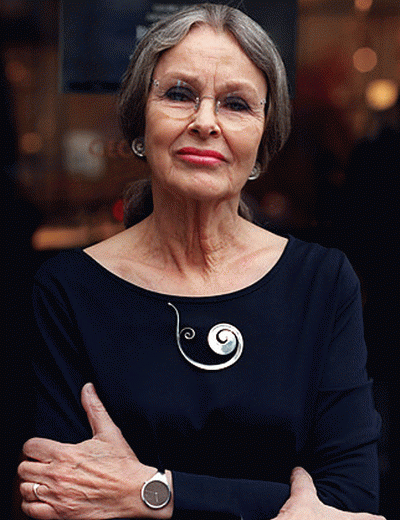
Vivianna Torun Bülow-Hübe
About
Vivianna Torun Bulow-Hube, know as Torun was born on December 7, 1927 in Malmo, Sweden. Her father was director of town planning in Malmo and her mother was a sculptor. Torun was the youngest of four children, born after a gap of nine years. All four children pursued artistic careers with a brother and sister becoming architects and another sister, a poet. But it was Torun who became the most famous, as the first woman silversmith in the world to gain international recognition.
Torun studied at Konstfack, the School of Arts, Crafts and Design in Stockholm, beginning in 1945 while pregnant with her first child, Pia. Eventually she married the child's father, a Danish journalism student. In 1948, Torun spent the summer in Paris meeting Picasso, Braque, Matisse and the other great artists of the day. She married a French architect and lived in Stockholm until 1956 having a second child, a son, Claude. As early as 1952, Torun exhibited her jewelry, made both in Stockholm and France (and bearing hallmarks from each country) in Paris.
In 1956, Torun and her husband divorced and she lost custody of her son. She moved to France with her third husband, Walter Coleman, an Afro-American painter, meeting many of the jazz greats of that time. She designed jewelry for among others, Billie Holiday which Holiday wore when she performed. The couple moved to Biot in the south of France in 1958 to avoid political problems they were encountering in Paris as a result of the war in Algeria.Torun produced many pieces during this period when young Swedish silversmiths would come to work in her studio, introducing her to new techniques. Torun renewed her acquaintance with Picasso who lived in the area and an exhibition of Torun jewelry was held at the Picasso museum in Antibes from 1958 to 1960. Torun had two children with Walter, Ira and Marcia.
In 1965, her marriage broke up and in 1966, she became involved with the Subud spiritual movement, an association which continues to today.
In 1961, Torun won the Lunning Prize which was awarded from 1951 to the 1970s to someone who had "pioneered a unique artistic contribution".
In 1968, she moved to Wolfsburg Germany and in 1975 to the neighboring village of Wendhausen to be closer to the Subud community. She had a workshop and worked with other artists in an association called "Die Schwinge".Beginning in 1967, Torun's production was taken over by Georg Jensen silver. Since moving to Germany, Torun has worked on things other than jewelry including cutlery, chinaware and handbags. In 1978, Torun moved to Indonesia where she still lives.
On November 5, 1992, Torun was awarded the Prince Eugen medal by King Carl XVI Gustav of Sweden. The medal ia bestowed for outstanding artistic achievement.
In September of 1992 Georg Jensen in Copenhagen held an exhibition to celebrate 25 years of Torun's association with the company, 45 years of working with silver and her 65th birthday. From October 1992 to January 1993, the Musee des Arts Decoratifs in the Louvre held a 45 year retrospective of Torun's work.